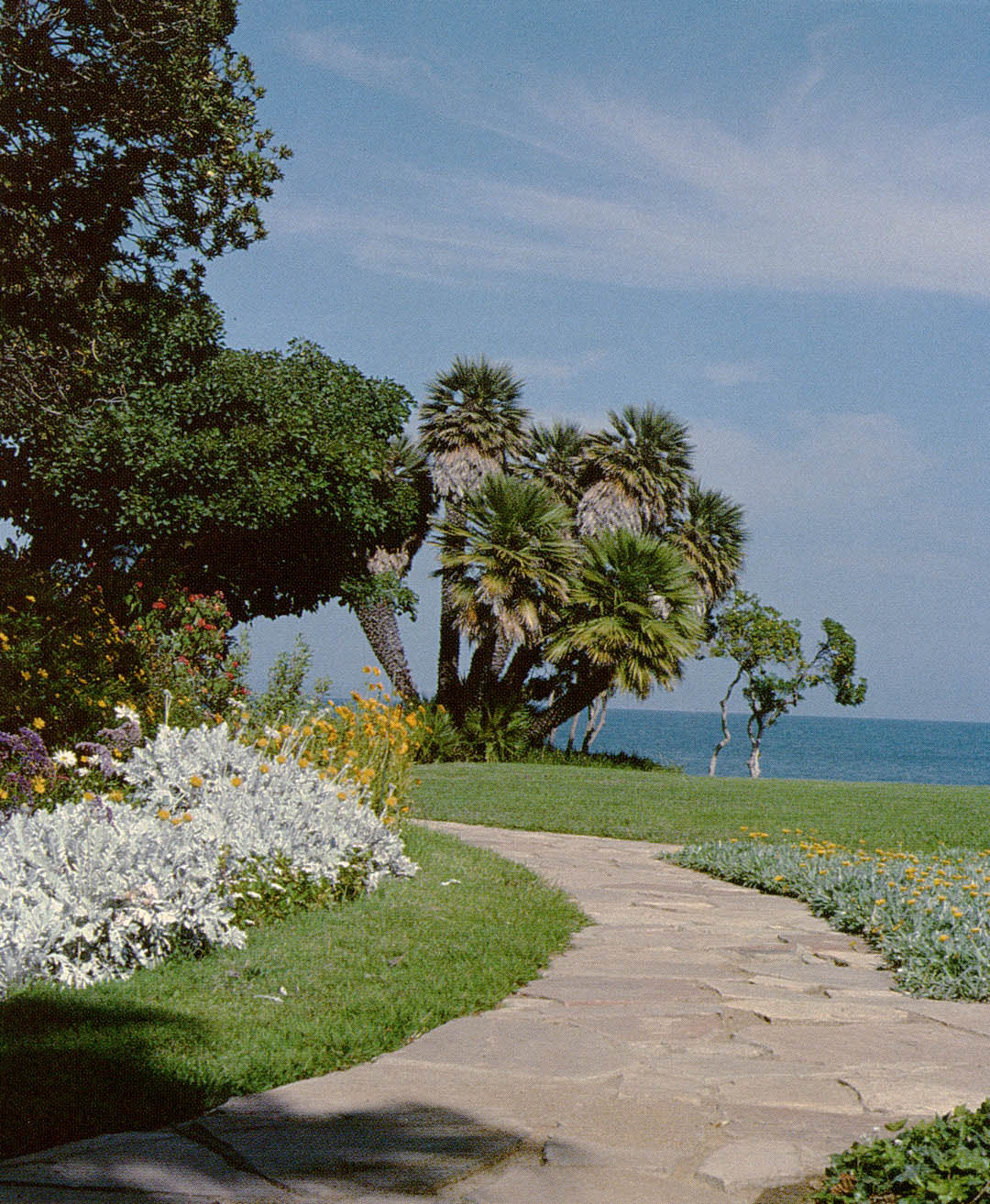
A Garden to Adohr

Contributor
- Topics: Inspired Gardens and Design

This lovely seaside garden is open daily from approximately 7am until dark. (The Adamson House and Malibu lagoon Museum are open only Wednesday through Saturday between 10am and 2pm.)
Slumbering behind unprepossessing gray walls one-half block south of downtown Malibu’s busiest intersection is a thirteen-acre oasis, the home gardens and grounds of the Adamson House. Visitors are dazzled by the house — a National Historical Site and California Landmark that is considered a shrine for lovers of ceramic arts and design — and are intrigued by local history presented in the adjacent Malibu Lagoon Museum, but the grounds are often overlooked. Lush, serene, and picturesque, the house and museum site nearly succumbed to the syndrome singer Joni Mitchell condemned as “pave paradise, put up a parking lot” until people who knew better and cared more prevailed.
The handsome, tile-embellished 1929 house was the home of Rhoda Rindge Adamson, only daughter of the last and most tenacious family to own what was once known as Rancho Topanga Malibu Sequit. Rhode spelled backwards provides the name for the line of Adohr dairy products, an enterprise she and her husband founded in 1916. Mrs Adamson occupied the house until her death in 1962. A half-dozen years later the state acquired the house and surrounding grounds, and for a number of years while its fate hung in the balance it was home to the chancellor of nearby Pepperdine University. Today the grounds surrounding the Hispano-Moorish Colonial Revival style house are devotedly tended by a group of docents who have compiled a list of the plants and their locations for the benefit of visiting gardeners.
This is not a collection with the botanical breadth and diversity of, say, the Los Angeles State and County Arboretum, nor is it as grand or hushed as the famous Huntington Botanical Gardens. But what has been achieved on the intimate scale of the Adamson grounds is Malibu’s only public botanic garden. And there is one element here that none of the noted inland gardens can match: the Pacific Ocean as background.
Situated between the cacophony of the Pacific Coast Highway just south of Cross Creek Road and the soft swish of waves on Malibu Surfrider Beach, this haven of multi-level, flower-fringed lawns is invitingly sprinkled with shaded benches, stone garden seats, and ocean-view picnic tables. Examples of some uncommonly encountered trees heighten the sense of discovery. Among these is the broadleaf evergreen primrose tree or cowitch tree (Lagunaria patersonii), from Australia, bearing creamy-pink hibiscus-like flowers that evolve into persistent, rough-surfaced nut-like capsules. Their trunks are slender and upright. Several trees may be found lining the lower tier, left-hand side of the pathway leading oceanward from the large flagstone courtyard.
A gnarled, deciduous tree gardenia, Gardenia thunbergia, opposite the lath house perfumes the footpath skirting the lawn between the entrance and tiny one-room gift shop. In front of the gift shop several species of guava are planted: the more common pineapple guava (Feijoa sellowiana); guava (Psidium guajava); and lemon guava (P. Iittorale). Tufts of intensely colored stamens are the conspicuous feature of these flowers. The guavas shade the stairway leading unexpectedly down to a vibrant tile-work fountain overhung by the sunset-colored flowers of the marmalade bush (Streptosolen jamesonii). According to docents, several of the trees seen today were barged in as mature specimens, including the large, thick-limbed old kaffirboom (Erythrina caffra), one of the coral trees growing on a slope above a side patio on the landward side of the house. Soil, too, had to be brought in. The site was originally known as Sand Hill.
As the grounds are by no means large, this preponderance of unusual and showy flowering trees is impressive, reflecting a freshness and bent for experimentation in the selection of plants for the original garden. The garden’s beacon or trademark tree is a lone bunya-bunya (Araucaria bidwillii) visible from the Pacific Coast Highway. The tree, an Australian native, towers above the gift shop at the end of an avenue of pride of Madeira (Echium fastuosum) in voluptuous bloom. The latter’s tall, branched flower spikes bear many short racemes of pink-hued buds opening to small florets of richest blue fading to lavender with age. At the tips of the bunya-bunya’s long, naked, pendent branches are dangling clumps of glossy, pointed, overlapping leaves. A branching pattern arranged like the spokes of a bicycle wheel makes the tree a distinctive landmark. Forming a color-splashed apron around its trunk is a garden of hardy fuchsias, orange clivias, reed-stemmed orchids, golden Alyssum saxatile, blue forget-me-nots, and other annuals and perennials.
Small as the garden is, first-time and frequent visitors are always surprised: perhaps by the wisteria woven along one side of the gift shop’s porch, or the cymbidium orchids and bromeliads thriving in happy circumstances beneath olive and pomegranate trees just outside the courtyard; or by the one remarkable sycamore dominating the lower lawn and, to its right, the South African honey bush (Melianthus major) with crimson flower spikes curving above large, pale, gray-green leaves deeply divided into toothed leaflets; or by the stout old Canary Island date palms (Phoenix canariensis) between whose fronds may be glimpsed glistening, guII-dotted Malibu Lagoon.










Responses